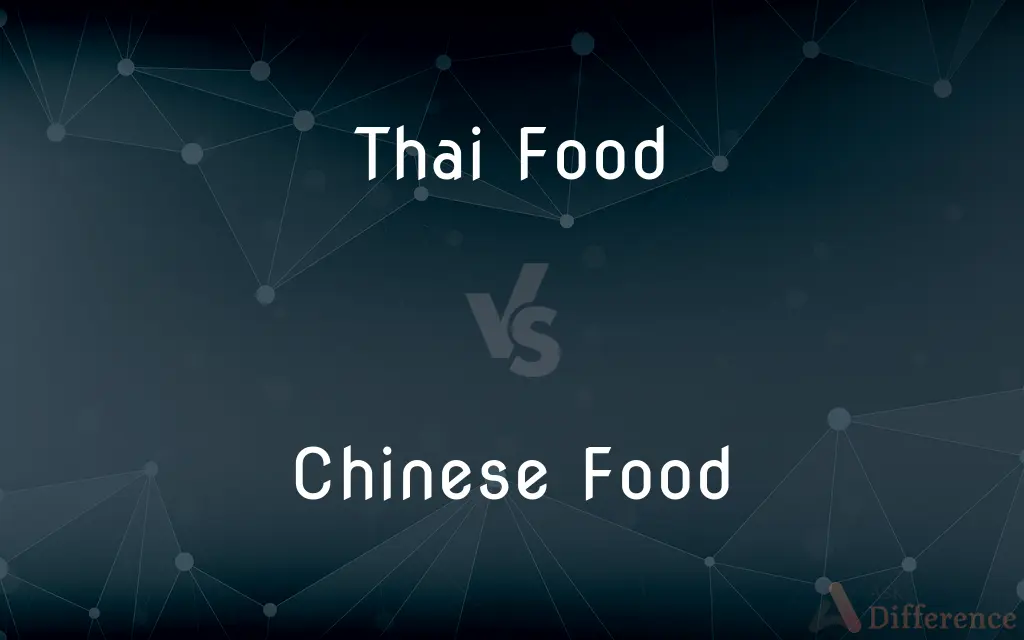Thai Food vs. Chinese Food — What's the Difference?
By Maham Liaqat & Fiza Rafique — Published on October 4, 2024
Thai food emphasizes fresh herbs and spices with a balance of sweet, sour, salty, and spicy flavors. Chinese food, in contrast, often focuses on soy sauce-based seasonings and is known for its regional diversity, including Szechuan and Cantonese cuisines.

Difference Between Thai Food and Chinese Food
Table of Contents
ADVERTISEMENT
Key Differences
Thai cuisine is celebrated for its heavy use of fresh herbs like basil, cilantro, and lemongrass, alongside a notable incorporation of coconut milk in many dishes, offering a distinct blend of flavors that is both aromatic and vibrant. Chinese cuisine, while also utilizing herbs, primarily relies on sauces such as soy and oyster for flavor, showcasing a more subtle and varied taste profile that reflects its vast regional culinary traditions.
The hallmark of Thai food is its emphasis on a harmony of flavors: spicy, sour, sweet, and salty, often achieved through the use of ingredients like fish sauce, lime juice, and sugar. This balance is distinctive and central to its identity. Chinese food, however, tends to focus on the principles of "fan" (grains and staples) and "tsai" (vegetable and meat dishes), aiming for a balance in texture and nutritional value rather than a stark contrast in flavors.
Thai meals typically include a single dish for individual diners, often a noodle dish, accompanied by a variety of shared plates that everyone at the table partakes in. This encourages a communal dining experience centered around variety and sharing. In contrast, Chinese meals are structured around shared dishes placed at the center of the table, with diners usually having their own bowl of rice or noodles, emphasizing family-style dining that highlights diversity in dishes.
Spiciness is a defining feature of Thai cuisine, with many dishes featuring fresh chili peppers and chili powder to achieve their characteristic heat. Chinese food includes spicy dishes, especially in regions like Sichuan and Hunan, but overall, it offers a wider range of flavors catering to different palates, including sweet, sour, and umami, without a universal emphasis on heat.
Thai cuisine's popularity in the global culinary scene can be attributed to its distinctive taste and aesthetic appeal, with dishes like Pad Thai and Green Curry being internationally recognized. Chinese cuisine enjoys a similarly widespread appeal, known for its versatility and depth, from Dim Sum to Peking Duck, reflecting centuries of culinary evolution and cultural exchange.
ADVERTISEMENT
Comparison Chart
Base Flavors
Sweet, sour, salty, spicy
Varied, often umami and soy-based
Common Ingredients
Fresh herbs, coconut milk, fish sauce
Soy sauce, vegetables, meats
Meal Structure
Individual and shared dishes
Primarily shared family-style dishes
Spiciness
Generally spicy
Ranges from mild to spicy, depending on the region
Global Recognition
Known for dishes like Pad Thai and Green Curry
Famous for Dim Sum, Peking Duck, among others
Compare with Definitions
Thai Food
Often features a communal dining experience.
A typical Thai meal includes several dishes shared by everyone at the table.
Chinese Food
Includes a wide variety of cooking methods, including steaming and stir-frying.
Dumplings are typically steamed, while stir-fry is a common technique for vegetables and meats.
Thai Food
Includes a variety of noodle dishes unique to Thai cuisine.
Pad Thai is a globally recognized noodle dish with a sweet and sour taste.
Chinese Food
Known for its emphasis on texture and balance.
Crispy Peking Duck contrasts with soft steamed buns for a balanced experience.
Thai Food
Thai food combines the sweet, sour, salty, and spicy, with a notable use of fresh herbs.
Tom Yum Soup is a perfect example of Thai cuisine’s balance of flavors.
Chinese Food
Relies on soy sauce and fermented products for flavor.
Soy sauce is a staple ingredient in many Chinese dishes, providing umami.
Thai Food
Known for its spiciness and use of coconut milk.
Green Curry embodies the creamy and spicy profile of Thai dishes.
Chinese Food
Chinese food is characterized by its regional diversity, like Cantonese and Szechuan cuisines.
Cantonese food is known for its mild flavors, while Szechuan cuisine is famously spicy.
Thai Food
Emphasizes fresh ingredients and vibrant flavors.
A Thai salad often contains raw herbs and spices with a spicy dressing.
Chinese Food
Features a family-style meal structure.
A Chinese dinner often involves shared dishes where everyone can sample a bit of everything.
Common Curiosities
How do Thai and Chinese foods differ in meal structure?
Thai meals often mix individual and shared dishes, while Chinese meals focus on shared, family-style dishes.
What makes Thai food spicy?
Thai food gets its spiciness from the liberal use of fresh chili peppers and chili powders.
Can I find vegetarian options in both Thai and Chinese cuisines?
Yes, both cuisines offer vegetarian dishes, though Thai cuisine often uses fish sauce as a base flavor.
What is a common ingredient unique to Thai food?
Coconut milk is frequently used in Thai dishes, adding a creamy texture and sweet flavor.
Is Chinese food always based on soy sauce?
While soy sauce is common, Chinese cuisine varies greatly, and not all dishes are soy sauce-based.
Why is Chinese food considered diverse?
China's vast geography and cultural differences lead to a wide range of flavors, ingredients, and cooking techniques.
Are there any similarities between Thai and Chinese foods?
Both cuisines emphasize communal dining and the balance of flavors, though their approaches and ingredients differ.
Can I find spicy food in Chinese cuisine?
Yes, especially in regions like Szechuan and Hunan, known for their use of chili peppers.
What is a typical feature of Chinese cuisine's flavor profile?
It often includes a balance of umami flavors achieved through the use of soy sauce and fermented products.
What's a signature dish for Thai cuisine?
Pad Thai, a stir-fried noodle dish, is iconic of Thai cuisine.
What defines a traditional Chinese meal?
A traditional Chinese meal includes a variety of shared dishes with a balance of meats, vegetables, and carbohydrates.
How do Thai and Chinese cuisines approach the concept of umami?
Thai cuisine achieves umami through fish sauce and shrimp paste, while Chinese cuisine uses soy sauce and fermented bean paste.
How does the use of herbs differ between Thai and Chinese cooking?
Thai cooking uses fresh herbs for flavor, while Chinese cooking uses them more sparingly, often for medicinal purposes.
Is rice important in both Thai and Chinese cuisines?
Yes, rice is a staple in both cuisines, though the preparation and types may vary.
What role does coconut milk play in Thai food?
It's used to add creaminess and sweetness, particularly in curries and soups.
Share Your Discovery

Previous Comparison
MLA Style vs. Chicago Style
Next Comparison
Aromatic Compounds vs. Aliphatic CompoundsAuthor Spotlight
Written by
Maham LiaqatCo-written by
Fiza RafiqueFiza Rafique is a skilled content writer at AskDifference.com, where she meticulously refines and enhances written pieces. Drawing from her vast editorial expertise, Fiza ensures clarity, accuracy, and precision in every article. Passionate about language, she continually seeks to elevate the quality of content for readers worldwide.














































